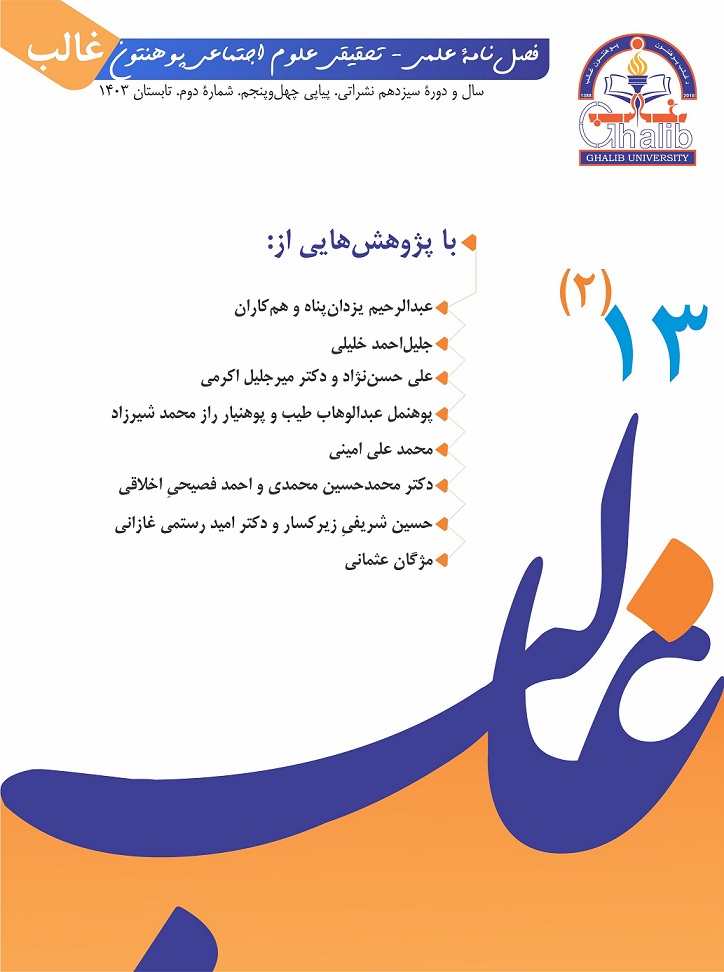Analyzing the types of semantic deviance in Kalileh and Damanah Nasrallah Menshi with an emphasis on the example of Sajjoudi
(با تأکید بر الگوی سجودی)
DOI:
https://doi.org/10.58342/ghalibqj.V.13.I.2.3Keywords:
Defamiliarization, Kalileh and Demneh, Semantic Norm Deviation, Nasrullah Monshi, Technical ProseAbstract
The essential and irrefutable position of the Persian language and literature as one of the most significant and influential literatures among the world literature is a clear and obvious thing, and in the meantime, the amazing influence that the language has as the main means of communication and creation of works of art on The literature is brilliant. Poets and writers can use different tools to take advantage of the power of language in literature so that to enrich their literary works. One of the tools is the semantic avoidance. Semantic norm avoidance is one of the tools of literary creation in poetry, and its investigation in prose will lead to its manifestation and poeticization. The authors of the research, using the descriptive-analytical method and library studies, while relying on the model presented by Farzan Sajudi (1378), to categorize the types of semantic norm avoidance based on the framework proposed by Leach (1969), to define semantic norm avoidance. In terms of prostration and explanation of its types, they have presented the frequency of each of them in the book of Kalileh and Demneh. The results of this research show that in the book Kalileh and Demnah Nasrullah Munshi, semantic deviance by the method of objectification is used more and its frequency compared to other types of semantic deviance is more, and this topic can be used in stylistics studies. This great work and its difference with other works of the same period should be taken into consideration.
References
۱. آهنگر، عباسعلی؛ مشهدی، محمدامیر و بهاره محمد فرج. (1402). «بررسی ارجاع مشارکین در هشت باب از کلیله و دمنه». مطالعات شبه قاره. 15(44). 9-28. doi: 10.22111/jsr.2021.37411.2152.
۲. احمدی، بابک. (۱۳۸۵). ساختار و تأويل متن. ج ۱. تهران: مرکز.
۳. انوشه، حسن. (۱۳۷۶). فرهنگنامهٔ ادب فارسی. تهران: وزارت فرهنگ و ارشاد اسلامی.
۴. امیرعلایی، ندا. (۱۳۷۸). سبکشناسی شعر شاملو در چارچوب زبانشناسی ساخت گرا. تهران: دانشگاه.
۵. ایگلتون، تری. (۱۳۸۶). نظريهٔ ادبی. ترجمهٔ عباس مخبر. تهران: نشر مرکز.
۶. برتنس، هانس. (۱۳۸۷). مبانی نظریهٔ ادبی. ترجمهٔ محمدرضا ابوالقاسمی. تهران: ماهی.
۷. تسلیمی، علی؛ محمدپور، لیلا. (1391). «برجستهسازی در داستان کوتاه سه قطره خون». پژوهشهای نقد ادبی و سبکشناسی. شمارهٔ 7. 97-117. http://noo.rs/t5wzA.
۸. حسن پورآلاشتی، حسین. (1389). «هنجارگریزی در قصاید خاقانی». ادبیات فارسی. 6(25). 30-43. SID. https://sid.ir/paper/194187/fa.
۹. رزاقی شانی، علی. (1391). «معانی "را" در کلیله و دمنه». رشد زبان و ادب فارسی.
۱۰. روحانی، مسعود؛ عنایتی قادیکلایی، محمد. (1388). «بررسی هنجارگریزی در شعر شفیعی کدکنی (م.سرشک)». پژوهشهای ادب عرفانی (گوهر گویا). 3(3(پیاپی 11)). 63-90. SID. https://sid.ir/paper/123785/fa.
۱۱. سجودی، فرزان. (۱۳۷۹). سبکشناسی شعر سپهری: رویکردی زبانشناختی. تهران: دانشگاه علامه طباطبایی.
۱۲. سجودی، فرزان. (1377). «هنجارگریزی در شعر سهراب سپهری». کیهان فرهنگی. -(142). 20-23. SID. https://sid.ir/paper/448822/fa.
۱۳. سجودی، فرزان. (۱۳۷۸ الف). «توهم حضور: نقدی بر هنجارگریزی لیچ و اصل رسانهگی شفیعی کدکنی». هنر. شماره ۴۲. ۱۸-۲۲.
۱۴. سجودی، فرزان. (1378 ب). «درآمدی بر نشانهشناسی شعر». شعر. 7(26). 0-0. SID. https://sid.ir/paper/448232/fa
۱۵. شفیعیکدکنی، محمدرضا. (1373). موسیقی شعر. چ سوم. تهران: آگاه.
۱۶. شمیسا، سیروس. (1390). بیان. ویراست چهارم. تهران: انتشارات میترا.
۱۷. صالح، گلریز. (1389). «قاعدهکاهی در نثر گلشیری». زبان شناخت. 1(1 (پیاپی 1)). 43-56. SID. https://sid.ir/paper/221917/fa.
۱۸. صفوی، کورش. (۱۳۸۱). «هنجارگریزی». در فرهنگنامة ادبی فارسی. ج ۲. به سرپرستی حسن انوشه. تهران: وزارت فرهنگ و ارشاد اسلامی. ص۱۴۴۵-۱۴۴۶.
۱۹. صفوی، کورش. (۱۳۸۳). از زبانشناسی به ادبیات. ج ۱ و ۲. تهران: انتشارات سورة مهر.
۲۰. مبارک، وحید؛ کریمی، نسیم. (1399). «شالودهشکنی داستان زرگر و سیّاح کلیله و دمنه». پژوهشنامهٔ متون ادبی دورۀ عراقی. 1(1). 77-93. https://motounadabi.razi.ac.ir/article_1428.html.
۲۱. محسنی، مرتضی؛ صراحتی جویباری، مهدی. (1390). «بررسی انواع هنجارپریزی آوایی و واژهگانی در شعر ناصر خسرو». سبکشناسی نظم و نثر. شمارهٔ 8. 1-24. http://noo.rs/EzKPw.
۲۲. محمدی، محمدحسین. (1381). «آشناییزدایی در غزلیات شمس». دانشکدهٔ ادبیات و علوم انسانی (تهران). 4(5-4 (ضمیمه)). 211-221. SID. https://sid.ir/paper/33443/fa.
۲۳. محمودی، مریم. (1393). «تشبیه برجستهترین ویژهگی سبکی کلیله و دمنه». فنون ادبی. 6(2 (پیاپی 11)). 121-132. SID. https://sid.ir/paper/475218/fa.
۲۴. معینالدینی، فاطمه. (1382). «شگردهای ایجاد انسجام متن در کلیله و دمنه». فرهنگ. 16(47-46)، 303-326. SID. https://sid.ir/paper/477611/fa.
۲۵. منشی، ابوالمعالی نصرالله. (1393). کلیله و دمنه. به تصحیح مجتبی مینوی. چ دوم. تهران: ثالث.
۲۶. مهرآورگیگلو، قاسم. (1394). «بررسی هنجارگریزی معنایی در مرزباننامه». همایش بینالمللی انجمن ترویج زبان و ادب فارسی ایران. SID. https://sid.ir/paper/855633/fa.
۲۷. مدرسی، فاطمه؛ یاسینی، امید. (1387). «قاعدهافزایی در غزلیات شمس». تاریخ ادبیات (پژوهشنامهٔ علوم انسانی). -(59/3). 119-143. SID. https://sid.ir/paper/170314/fa.
۲۸. وفایی، عباسعلی، قاسم محمد، فاطمه. (۱۳۹۴). «تحول معنایی وامواژههای عربی در کلیله و دمنه». پژوهشهای ادبیات تطبیقی. ۳ (۱) :۲۲۳-۲۴۶. http://clrj.modares.ac.ir/article-12-4016-fa.html.
Leech, G. N. (1969). A Linguistic Guide to English Poetry. New York: Longman.
P. and M. Iraji. (2013). The Linguistic Study of Prose Style in Buf-e-Kur
by Sadegh Hedayat an Iranian writer with respect to the Frequency of Different Types of Deviation. International Research Journal of Applied and Basic Sciences, 4(6), 1454-1460.
References
Ahangaran, Abbasali; Mashhadi, Mohammadamir, and Bahareh Mohammad Faraj. (2023). "Examining Participant References in Eight Chapters of Kalila and Dimna." Subcontinent Studies. 15(44). 9-28. doi: 10.22111/jsr.2021.37411.2152. (Persian)
Ahmadi, Babak. (2006). Structure and Interpretation of the Text. Vol. 1. Tehran: Markaz. (Persian)
Anousheh, Hassan. (1997). Dictionary of Persian Literature. Tehran: Ministry of Culture and Islamic Guidance. (Persian)
Amiralaei, Neda. (1999). Stylistics of Shamlu's Poetry within the Framework of Structural Linguistics. Tehran: University. (Persian)
Eagleton, Terry. (2007). Literary Theory. Translated by Abbas Mokhber. Tehran: Nashr-e Markaz. (Persian)
Bertens, Hans. (2008). Literary Theory: The Basics. Translated by Mohammadreza Aboulghasemi. Tehran: Mahi. (Persian)
Taslimi, Ali; Mohammadpour, Leila. (2012). "Foregrounding in the Short Story 'Three Drops of Blood'." Literary Criticism and Stylistics Research. Issue 7. 97-117. http://noo.rs/t5wzA. (Persian)
Hasanpour Alashti, Hossein. (2010). "Deviation in Khaqani's Qasidas." Persian Literature. 6(25). 30-43. SID. https://sid.ir/paper/194187/fa. (Persian)
Razaghi Shani, Ali. (2012). "Meanings of 'Ra' in Kalila and Dimna." Growth of Persian Language and Literature. (Persian)
Rouhani, Masoud; Enayati Qadikolaei, Mohammad. (2009). "Examining Deviation in the Poetry of Shafi'i Kadkani (M. Sereshk)." Mystical Literature Research (Gohar-e Goya). 3(3(11)). 63-90. SID. https://sid.ir/paper/123785/fa. (Persian)
Sojoodi, Farzan. (2000). Stylistics of Sohrab Sepehri's Poetry: A Linguistic Approach. Tehran: Allameh Tabataba'i University. (Persian)
Sojoodi, Farzan. (1998). "Deviation in the Poetry of Sohrab Sepehri." Keyhan Farhangi. -(142). 20-23. SID. https://sid.ir/paper/448822/fa. (Persian)
Sojoodi, Farzan. (1999a). "The Illusion of Presence: A Critique of Leech's Deviation and Shafi'i Kadkani's Medial Principle." Art. Issue 42. 18-22. (Persian)
Sojoodi, Farzan. (1999b). "An Introduction to Semiotics of Poetry." Poetry. 7(26). 0-0. SID. https://sid.ir/paper/448232/fa. (Persian)
Shafi'i Kadkani, Mohammad Reza. (1994). The Music of Poetry. 3rd edition. Tehran: Agah. (Persian)
Shamisa, Siroos. (2011). Rhetoric. 4th edition. Tehran: Mitra Publications. (Persian)
Saleh, Golriz. (2010). "Understatement in Golshiri's Prose." Linguistics. 1(1(1)). 43-56. SID. https://sid.ir/paper/221917/fa. (Persian)
Safavi, Kourosh. (2002). "Deviation." In Dictionary of Persian Literature. Vol. 2. Edited by Hassan Anousheh. Tehran: Ministry of Culture and Islamic Guidance. pp. 1445-1446. (Persian)
Safavi, Kourosh. (2004). From Linguistics to Literature. Vols. 1 and 2. Tehran: Sooreh Mehr Publications. (Persian)
Mobarak, Vahid; Karimi, Nasim. (2020). "Deconstruction of the Story of the Goldsmith and the Traveler in Kalila and Dimna." Journal of Literary Texts of the Iraqi Era. 1(1). 77-93. https://motounadabi.razi.ac.ir/article_1428.html. (Persian)
Mohseni, Morteza; Sarrahti Jouybari, Mahdi. (2011). "Examining Types of Phonetic and Lexical Deviation in Naser Khosrow's Poetry." Stylistics of Verse and Prose. Issue 8. 1-24. http://noo.rs/EzKPw. (Persian)
Mohammadi, Mohammad Hossein. (2002). "Defamiliarization in Rumi's Ghazals." Faculty of Literature and Humanities (Tehran). 4(5-4(Supplement)). 211-221. SID. https://sid.ir/paper/33443/fa. (Persian)
Mahmoudi, Maryam. (2014). "Simile as the Most Prominent Stylistic Feature in Kalila and Dimna." Literary Techniques. 6(2(11)). 121-132. SID. https://sid.ir/paper/475218/fa. (Persian)
Moeineddini, Fatemeh. (2003). "Techniques for Creating Textual Coherence in Kalila and Dimna." Farhang. 16(47-46). 303-326. SID. https://sid.ir/paper/477611/fa. (Persian)
Monshi, Abolmaali Nasrallah. (2014). Kalila and Dimna. Edited by Mojtaba Minovi. 2nd edition. Tehran: Sales. (Persian)
Mehravargiglu, Ghasem. (2015). "Examining Semantic Deviation in Marzban Nameh." International Conference of the Iranian Association for the Promotion of Persian Language and Literature. SID. https://sid.ir/paper/855633/fa. (Persian)
Modarresi, Fatemeh; Yasini, Omid. (2008). "Hyperbole in Rumi's Ghazals." Literary History (Research Journal of Humanities). -(59/3). 119-143. SID. https://sid.ir/paper/170314/fa. (Persian)
Vafaei, Abbasali; Qasem, Mohammad, Fatemeh. (2015). "Semantic Evolution of Arabic Loanwords in Kalila and Dimna." Comparative Literature Research. 3(1): 223-246. http://clrj.modares.ac.ir/article-12-4016-fa.html. (Persian)
Leech, G. N. (1969). A Linguistic Guide to English Poetry. New York: Longman. (English)
P. and M. Iraji. (2013). The Linguistic Study of Prose Style in Buf-e-Kur
by Sadegh Hedayat an Iranian writer with respect to the Frequency of Different Types of Deviation. International Research Journal of Applied and Basic Sciences, 4(6), 1454-1460. (English)
Downloads
Published
How to Cite
Issue
Section
License
Copyright (c) 2024 علی حسننژاد،دکتر میرجلیل اکرمی

This work is licensed under a Creative Commons Attribution 4.0 International License.













